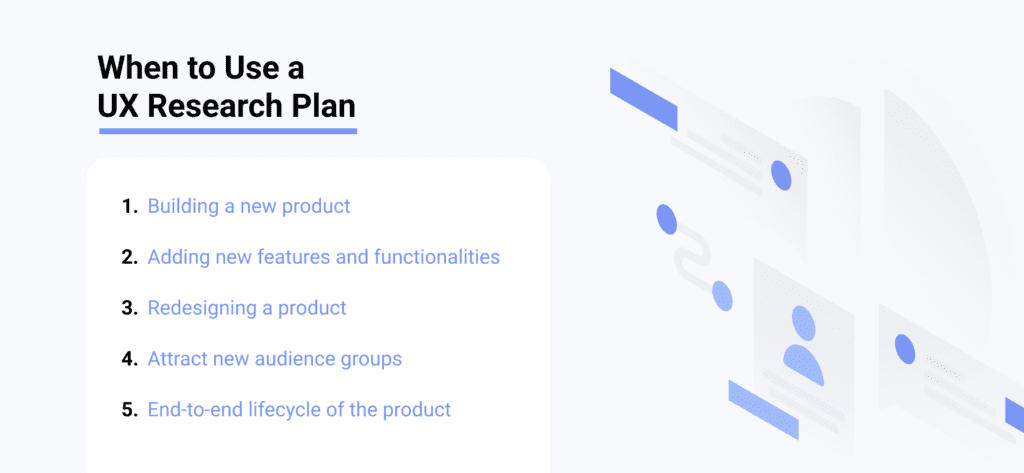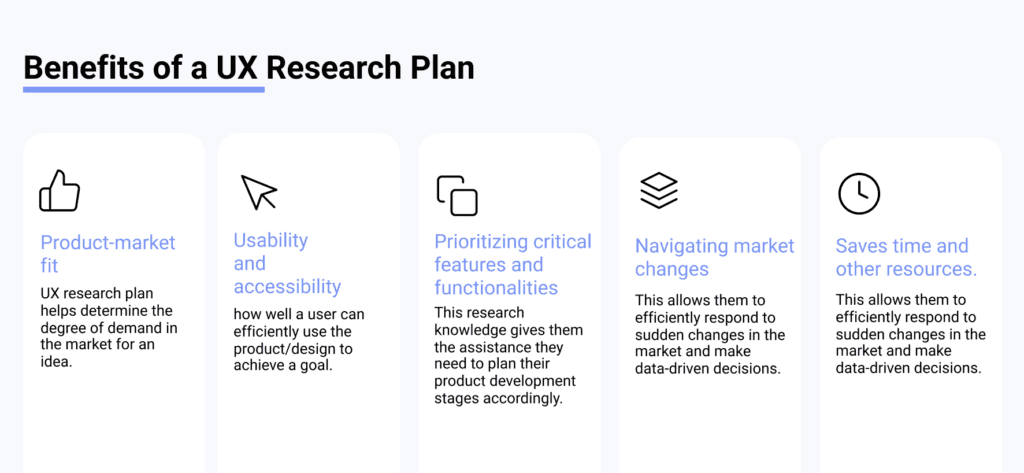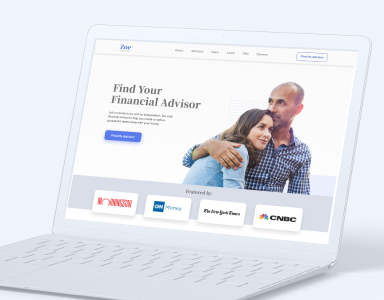articles
How to Create a UX Research Plan

Creating a UX research plan is the first step in the design process. It allows product managers and UX designers to gain a strategic view of the project and helps them focus on one primary aspect — user experience.
From the budget to the timeline, a UX research plan enables businesses to align the expectations of the team and the key stakeholders.
In this blog, we’ll guide you through the steps to create a UX research plan for your next project. But first, let’s understand what a UX research plan is and why it is important.

What Is a UX Research Plan?
UX research is a study of user interaction to gain valuable insights and an in-depth understanding of the target user’s needs, pain points, and behavioral characteristics to improve the design process.
These insights are obtained using numerous feedback techniques and observational methodologies.
The primary goal of building a UX research plan is to develop products backed by data and not assumptions about what the users are looking for.
It ensures that the product development team is focused on the outcome and doesn’t lose itself in the details.
Overall, a UX research plan is a guide for the research initiative conducted by the team, working as a kick-off guide for a new project, and narrowing down the primary purpose of the project.
When to Use a UX Research Plan
A UX research plan answers critical questions for teams. For example —
- Who is your ideal target audience?
- What are your customers looking for?
- Does the current design, or proposed design, meet the needs and expectations of your customer?
- Is there any way to make the design more efficient?
Furthermore, building a UX research plan provides companies with the opportunity to:
- Determine what works best for your stakeholders, especially when it comes to the questions they’re trying to answer.
- Keep your stakeholders engaged and interested in your products.
- Help stakeholders understand your vision, the challenges you’re trying to tackle, and the methodologies you’re using for research.

A UX research plan is an excellent way to align expectations, ask for honest feedback, and generate support for improving the value of UX research in the company.
Let’s take a look at specific use cases when UX research is crucial.
- Building a new product.
When a company develops a new product, it’s vital to conduct in-depth research before anything else. It helps them identify the needs of their target audience and helps them ensure that their product meets their expectations.
Furthermore, before building a new product, it’s crucial to analyze other competitor products in the market.
What are their strengths and weaknesses? Are there any feature gaps that you can fill with your product? Why is your product better than the others already on the market?
A UX research plan helps align the entire team and the stakeholders on the project and business goals at an early stage. - Adding new features and functionalities
When adding new features to an existing product, businesses can use the same approach as the one they used while developing a new product.
Research the market, understand the pain points and determine the problems they want to solve.
- Redesigning a product.
Businesses should make data-driven decisions while redesigning their product. They should learn from their existing user base and analyze their behavior before making design decisions.
When you pair UX research plans with other testing methodologies like usability testing and A/B testing, you’ll be able to redesign your product in a foolproof manner. - Attract new audience groups
If a business plans to expand to a new market in an effort to reach more users, it’s critical to analyze this new audience — their wants, needs, expectations, and more.
Businesses can make the research more accurate by using techniques like user interviews, surveys, field studies, personas, and more. - End-to-end lifecycle of the product
Research has to be an integral part of the product’s entire lifecycle. This helps businesses stay competitive by constantly discovering ways to improve their product, stay on top of emerging trends, and identify potential market fluctuations.
This information enables companies to react faster to these changes and adapt their product accordingly.

Benefits Of A UX Research Plan
Product-market fit
UX research plan helps determine the degree of demand in the market for an idea.
If a product is created and developed based on concrete data collected via UX research methodologies, it’s safe to say that it will achieve a high level of product-market fit.
Usability and accessibility
Usability defines how well a user can efficiently use the product/design to achieve a goal.
Obviously, usability has a massive impact on the engagement and conversion rate of any product.
Furthermore, if a company ensures that its product offers maximum usability for people with varied limitations and disabilities, it boosts the overall user experience.
With a UX research plan, businesses can also identify other temporary limitations that their users face on varied scenarios, like — using their product in a noisy place, when in a hurry, maybe under direct sunlight, and more.
Prioritizing critical features and functionalities
There are various UX research methodologies like user story mapping, competitor product analysis, and user interviews that can help businesses prioritize which features and functionalities are critical.
This research knowledge gives them the assistance they need to plan their product development stages accordingly.
This advance planning reduces the risk and the cost associated with product development.
Navigating market changes
A UX research plan empowers businesses with in-depth knowledge about their customers’ requirements and behaviors and a strong foundation in the ever-changing market.
This allows them to efficiently respond to sudden changes in the market and make data-driven decisions.
Saves time and other resources.
Some associate the UX research phase with additional time, money, and effort spent on building the product.

However, when you consider the big picture, investing time and other resources into building a detailed UX research plan helps businesses save massively down the lane.
A UX research plan gives companies insights that can help safeguard them from making mistakes or overlooking aspects that can snowball into expensive problems.
Therefore, implementing UX research early on in the product development process is one of the smartest decisions companies can make to avoid potential complications in the future.
Final Thoughts
Creating a UX research plan is an arduous process, but it is definitely worth the time and effort. It’s the easiest way to align expectations, gain feedback, and get everyone excited to support your project.
A UX research plan helps businesses bring clarity and structure to their project. You can use the guidelines we’ve shared in this blog to build your UX research plan. Feel free to add, remove, or modify aspects to fit your business!
If you’re looking for a UX design agency to help you build a foolproof UX research plan, you can book a free consultation with our team.


.png)

